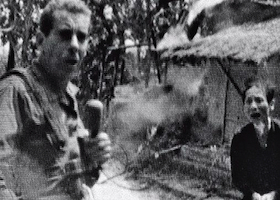This year NCAC celebrates 40 years on the frontlines of the censorship wars. As we revisit our 40 year history —and the recent history of censorship in the US —we will be looking at how information access, creative freedom and control over what we see and know have changed – or not.
The approach of Memorial Day reminds us how media coverage of war has changed in the last 40 years. The war in Vietnam was the first to be “fought in our living rooms”. TV was a young medium and political coverage on TV even younger. There were three TV networks (plus, after 1967, a fledgling PBS). Millions of families in millions of living rooms were watching the same newscasts. So, when CBS aired Morley Safer’s 1965 news report about the “search and destroy” mission to Cam Ne, the president of the network received an angry phone call from President Lyndon B. Johnson, questioning the network’s patriotism. When Walter Cronkite concluded his 1968 CBS documentary on the Tet offensive saying: “It is increasingly clear to this reporter that the only rational way out will be to negotiate, the President “flipped off the set and said, `If I’ve lost Cronkite, I’ve lost middle America.'”
The role of the media in fueling anti-Vietnam war sentiment may be exaggerated, and there certainly was no lack of government pressure, secrecy, and self-censorship in that era. Nevertheless, media exposure of American activities in Vietnam plainly helped spark opposition to the war; there is no better proof of this than the subsequent efforts to keep war coverage under close government control.
We watched the First Gulf War as if it were an abstraction seen from far away, involving bombs and machines, but not humans. Fast forwarding to post 9/11 war coverage: we now saw reporters “embedded” with troops, living in close quarters with them and allowed tightly controlled access to military action and its consequences for civilian populations; we had staged media events like the bringing down of the Saddam Hussein statue in Baghdad, or President Bush’s Mission Accomplished press spectacle; and we had a reprise of the First Gulf War rules against the photography of coffins of soldiers killed in action.
In a word, the war story coming through big media was carefully controlled. At the same time, however, there has been a virtual explosion of first person reports filmed on cellphones and distributed online.
The battle over control of information is never finally won or finally lost. While government is exercising more control over mainstream media’s war reporting, there are many more alternative sources of information. There are citizen witnesses, independent reporters, bloggers, whistleblowers, and leakers of inconvenient information. These provide the raw materials for many a contradictory narrative. But in terms of influencing public opinion and provoking a public response, the main media outlets still lead: the revelations about torture of Iraqi prisoners at Abu Ghraib were widely publicized through easily shared images on cellphone cameras, but it was the investigative reporting of Seymour Hersh published in and featured on CBS that made it a public scandal. The news that most often shapes policy is still the news that enters the living room, and this news is more controlled than ever.


